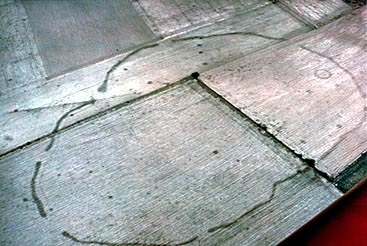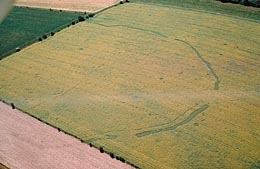- Home
- Discoveries
- The first farmers
- A Neolithic enclosure at l'Étoile
Large Neolithic enclosure, visible early in the morning thanks to residual patches of dampness. L'Étoile (Somme).
The site of l'Etoile was spotted in late winter in 1971. At the time, it was the first structure characteristic of the Neolithic era photographed in its entirety in northern France. Aerial photography revealed a vast interrupted-ditch enclosure, whose approximately oval-shaped layout appeared on bare ground, thanks to differential patches of damp that remained over a large, filled in ditch with eight interruptions. This ditch surrounded an area of nearly five hectares. The existence of a palisade lining the interior wall of the ditch was confirmed afterwards. Another palisade divides the enclosure into two parts, creating a roughly circular space in the interior of the enclosure. Core samples and excavations were carried out in the area of some of the entrances in 1973, and then in 1981 and 1984 (Bréart 1984). This research showed that the palisade was solid and consisted of large logs. The rubble taken from the dug ditch was banked against these logs on the inside, thus creating a small path from which one could keep watch.
Excavations at the Neolithic camp at l'Etoile (Somme).
The same site under cultivation. Parallel to the ditch, one can make out the traces of a palisade. L'Etoile (Somme).
Anthracological analyses have revealed that the logs were taken from oak trees. At the level of the interruptions in the big ditch, which is everywhere very large, the palisade has some very specific arrangements. There is, for example, a funnel-shaped structure, designed to channel and faciliate access to the enclosure's interior, while still being easy to seal off. The palisade is a signfiicant barrier that allows relatively limited access at places where the interruption of the ditch is several meters wide. Carbon-14, dating carried out on large pieces of charcoal found at the bottom of one of the palisade's postholes, and which were within the archaeological layer of the ditch, have given dates that extend from the end of the sixth to the end of the fifth millennium BCE. The main structure of the enclosure at l'Etoile dates to the Mid-Neolithic (or roughly 4,500 BCE), a culture that has been occasionally found in the Somme valley, but which is much more common in the Aisne and Oise valleys.


